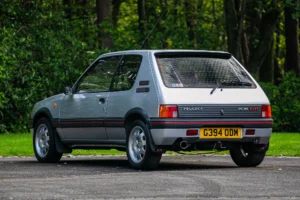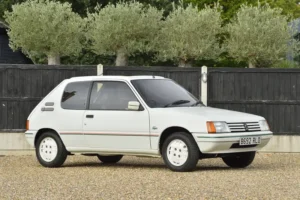
| Overview | |
| Manufacturer | Peugeot |
| Production | 2001–2008 (France) 2004–2011 (Argentina) 2001–2014 (China) |
| Assembly | Mulhouse, France (Mulhouse Plant) Sochaux, France (Sochaux Plant) Wuhan, China (Dongfeng) Villa Bosch, Argentina El Palomar, Argentina |
| Body and chassis | |
| Class | Small family car |
| Body style | 3 and 5-door hatchback 2-door coupé cabriolet 5-door estate 4-door saloon |
| Layout | Front-engine, front-wheel-drive |
| Platform | PSA PF2 platform |
| Related | Citroën C4 Citroën C4 Picasso Peugeot 3008 |
| Powertrain | |
| Engine | 1.4 L ET3 I4 (petrol) 1.6 L TU5 I4 (petrol) 1.6 L DV6 HDi I4 (diesel HDII) 2.0 L EW10 I4 (petrol) 2.0 L DW10 HDi I4 (diesel) |
| Dimensions | |
| Wheelbase | 2,610 mm (102.8 in) (hatchback, coupé cabriolet) 2,710 mm (106.7 in) (sedan, wagon) |
| Length | 4,210 mm (165.7 in) (hatchback) 4,350 mm (171.3 in) (coupé cabriolet) 4,420 mm (174.0 in) (wagon) 4,470 mm (176.0 in) (sedan) |
| Width | 1,730 mm (68.1 in) |
| Height | 1,510 mm (59.4 in) 1,420 mm (55.9 in) (coupé cabriolet) |
The Peugeot 307 is a small family car produced since 2001, following the Peugeot 306 which ceased production in 2002. It was awarded the European Car of the Year title for 2002, and continued to be offered in China and certain South American markets through 2014, despite the French launch of the 308 (its intended successor) in September 2007.
The 307 was presented as the 307 Prométhée prototype at the 2000 Mondial de l’Automobile. The production hatchback versions were introduced to the European markets on 26 April 2001, as a successor to the Peugeot 306. The 307 was also sold in Australia, New Zealand, Asia, and (in 1.6 and 2.0 petrol versions) Mexico. In Brazil, the 307 is sold with 1.6 and 2.0 flex (gas/ethanol) engines.
The 307 makes use of a reworked 306 platform, that can also be found on the Citroën Xsara as well as the 1991 Citroën ZX. However, the car is larger than the 306 in every direction. The 307 continued the company’s styling first seen on the Peugeot 206 and Peugeot 607. With upswept front lights and a steeply rising bonnet leading to a highly sloped windscreen (and the upright rear doors first seen on the 206), the 307 departed from the Pininfarina designed themes employed on the previous two generations of Peugeots, as introduced with the Peugeot 205, and ending with the (evolutionary) Peugeot 406.
In June 2005, the 307 was revised to meet the onslaught of rivals which had been launched since the introduction of the 307 four years earlier in 2001. The front of the car was restyled featuring mildly revised lights, a new bonnet and the removal of the trademark Peugeot grille between the headlights. With the latter change, along with a new front bumper, the front of the car was now dominated by a larger air intake, as first established on the Peugeot 407, and which was now effectively the company’s new grille.
The 307 was launched as a three and five door hatchback, though in June 2002, the 307 range was expanded, with the introduction of an estate car, the 307 SW. It features an optional third row of removable seats, so it is more flexible due to its MPV like configuration. The SW exists because Peugeot did not develop a compact MPV spinoff, as Citroën did with the Xsara Picasso, instead preferring to offer a more flexible version, but maintaining the style and road manners of an estate.
Unlike the previous model, there was no saloon version, but one was designed for emerging markets, such as China and the Latin American market, as saloons were much preferred to hatchbacks. The 307 CC, a cabriolet with a retractable hardtop, was launched in August 2003, to compete against the new European coupé cabriolets. In June 2004, a four door saloon version of the 307 was launched in China. This model was also built in Argentina between May 2006 and November 2010. Production ended in China in 2014.















